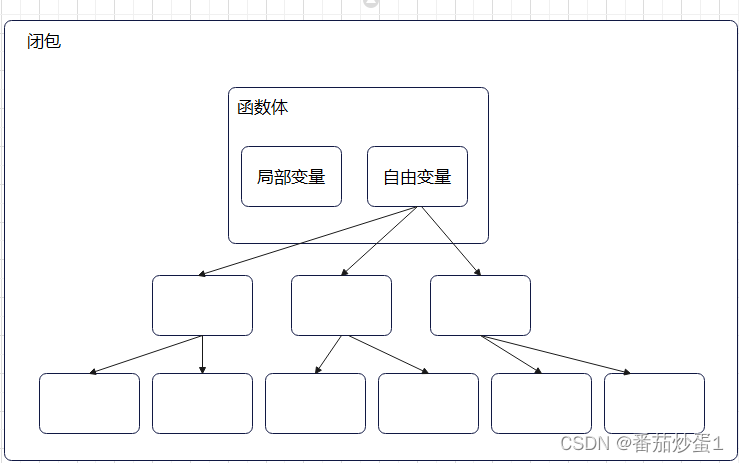函数式编程VS函数指针
- 函数是一等公民:参数,变量,返回值都可以是函数
- 高阶函数:函数的参数还可以是函数
- 函数->闭包
"正统"函数式编程
- 不可变性:不能有状态,只有常量和函数
- 函数只能有一个参数
- go语言是一个通用的语言,它不会再正统函数式编程做过多的文章
package main
import "fmt"
type iAdder func(int) (int, iAdder)
func adderi(base int) iAdder {
return func(i int) (int, iAdder) {
return base + i, adderi(base + i)
}
}
func main() {
a := adderi(0)
for i := 0; i < 10; i++ {
var s int
s, a = a(i)
// 0+1+...+0=0
// 0+1+...+1=1
// 0+1+...+2=3
// 0+1+...+3=6
// 0+1+...+4=10
// 0+1+...+5=15
// 0+1+...+6=21
// 0+1+...+7=28
// 0+1+...+8=36
// 0+1+...+9=45
fmt.Printf("0+1+...+%d=%d\n", i, s)
}
}
闭包
闭包可以理解成 “定义再一个函数内部的函数”.再本质上闭包是将函数内部和函数外部连接起来的桥梁.或者说是函数和其引用环境的组合体
package main
import "fmt"
func adder() func(int) int {
sum := 0
return func(i int) int {
sum += i
return sum
}
}
func main() {
a := adder()
for i := 0; i < 10; i++ {
// 0+1+...+0=0
// 0+1+...+1=1
// 0+1+...+2=3
// 0+1+...+3=6
// 0+1+...+4=10
// 0+1+...+5=15
// 0+1+...+6=21
// 0+1+...+7=28
// 0+1+...+8=36
// 0+1+...+9=45
fmt.Printf("0+1+...+%d=%d\n", i, a(i))
}
}

sum不是函数体里面定义的,是一个自由变量,自由变量就会连一根线连到sum上面,不断的找连接关系,连成一棵树最终会把所有我们要连接的变量都连到,就个就是函数式编程的闭包
其他语言的闭包
python中的闭包
def adder():
sum = 0
def f(value):
nonlocal sum
sum += value
return sum
return f
- python原生支持闭包
- 使用_closure_来查看闭包内容
c++中闭包
auto adder() {
auto sum = 0;
return [=] (int value) mutable {
sum += value;
return sum;
};
}
- 过去:stl或者boost带有类似库
- c++11及以后:支持闭包
java中的闭包
Function<Integer,Integer> adder(){
final Holder<Integer> sum = new Holder<>(0);
return (Integer value) -> {
sum.value += value;
return sum.value;
};
}
- 1.8以后:使用Function接口和Lambda表达式来创建函数对象
- 匿名类或Lambda表达式均支持闭包
go语言闭包应用
斐波那契数列
package main
import "fmt"
func fibonacci() func() int {
a,b:=0,1
return func()int{
a,b = b,a+b
return a
}
}
func main() {
f := fibonacci()
fmt.Println(f()) // 1
fmt.Println(f()) // 1
fmt.Println(f()) // 2
fmt.Println(f()) // 3
fmt.Println(f()) // 5
fmt.Println(f()) // 8
fmt.Println(f()) // 13
fmt.Println(f()) // 21
}
为函数实现接口
package main
import (
"bufio"
"fmt"
"io"
"strings"
)
func fibonacci() intGen {
a, b := 0, 1
return func() int {
a, b = b, a+b
return a
}
}
type intGen func() int
func (g intGen) Read(p []byte) (n int, err error) {
next := g()
if next > 10000 {
return 0, io.EOF
}
s := fmt.Sprintf("%d\n", next)
return strings.NewReader(s).Read(p)
}
func printFileContents(reader io.Reader) {
scanner := bufio.NewScanner(reader)
for scanner.Scan() {
fmt.Println(scanner.Text())
}
}
func fib(n int) int {
var res int
f := fibonacci()
for i := 1; i < n; i++ {
res = f()
}
return res
}
func main() {
f := fibonacci()
// 1
// 1
// 2
// ...
printFileContents(f)
}
使用函数遍历二叉树
package main
import "fmt"
type Node struct {
Value int
Left, Right *Node
}
func CreateNode(value int) *Node {
return &Node{Value: value}
}
func (node Node) Print() {
fmt.Print(node.Value, " ")
}
func (node *Node) SetValue(value int) {
if node == nil {
fmt.Println("node is nil")
return
}
node.Value = value
}
func (node *Node) Traverse() {
node.TraverseFunc(func(n *Node) {
n.Print()
})
fmt.Println()
}
func (node *Node) TraverseFunc(f func(node *Node)) {
if node == nil {
return
}
node.Left.TraverseFunc(f)
f(node)
node.Right.TraverseFunc(f)
}
func main() {
root := Node{Value: 3}
root.Left = &Node{Value: 1}
root.Right = &Node{5,nil,nil}
root.Right.Left = new(Node)
root.Left.Right = CreateNode(2)
root.Right.Left.SetValue(4)
// 1 2 3 4 5
root.Traverse()
count := 0
root.TraverseFunc(func(node *Node) {
count++
})
// 5
fmt.Println(count)
}
go语言对闭包的想法更为自然,不像其他的语言语法看起来怪怪的,不需要修饰如何访问自由变量,没有Lambda表达式,但是有匿名函数